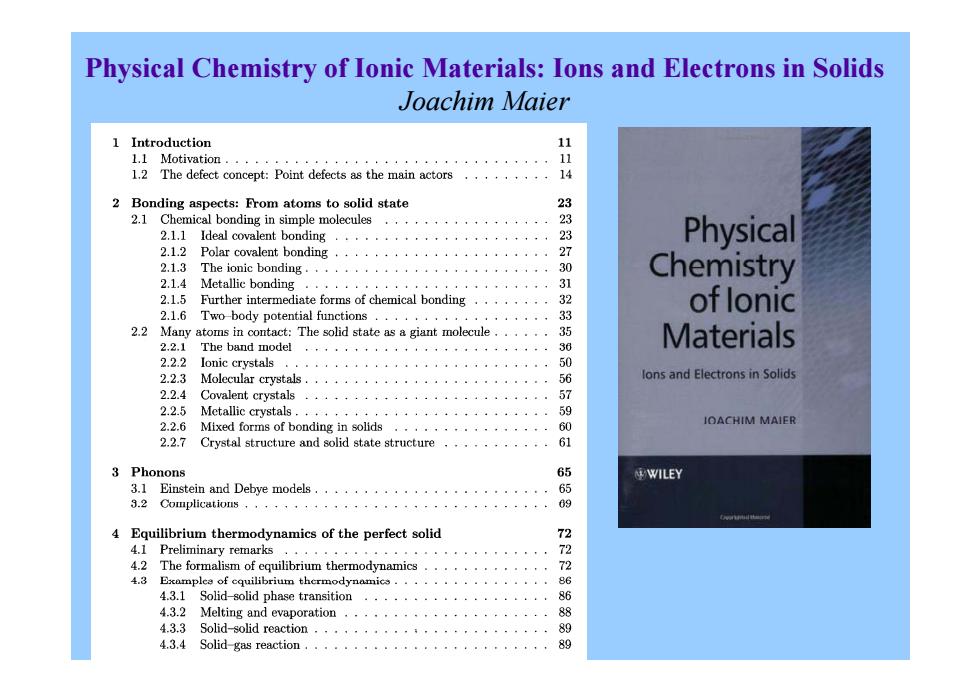
Physical Chemistry of lonic Materials:Ions and Electrons in Solids Joachim Maier 1 Introduction 11 1.1 Motivation +444 1.2 The defect concept:Point defects as the main actors 2 Bonding aspects:From atoms to solid state 2.1 Chemical bonding in simple molecules 23 2.1.1 Ideal covalent bonding Physical 2.1.2 Polar covalent bonding. 27 2.1.3 The ionic bonding. % Chemistry 2.1.4 Metallic bonding 31 2.1.5 Further intermediate forms of chemical bonding of lonic 2.1.6 Two-body potential functions 好 2.2 Many atoms in contact:The solid state as a giant molecule 。 2.2.1 The band model 36 Materials 2.2.2 lonic crystals 50 2.2.3 Molecular crystals lons and Electrons in Solids 2.2.4 Covalent crystals 2.2.5 Metallic crystals. g 2.2.6 Mixed forms of bonding in solids 60 IOACHIM MAIER 2.2.7 Crystal structure and solid state structure 61 3 Phonons 65 WILEY 3.1 Einstein and Debye models. 66 3.2 Complications 4 Equilibrium thermodynamics of the perfect solid 4.1 Preliminary remarks 2 4.2 The formalism of equilibrium thermodynamics.········, 72 4.3 Examples of cquilibrium thermodynamics.。.。 6 4.3.1 Solid-solid phase transition 8 4.3.2 Melting and evaporation,.,.,·,··。 4.3.3 Solid-solid reaction,.。··,s····,······· 89 4.3.4 Solid-gas reaction
Physical Chemistry of Ionic Materials: Ions and Electrons in Solids Joachim Maier Joachim Maier

Physical Chemistry of lonic Materials:Ions and Electrons in Solids 4.3.5 Phase equilibria and mixing reactions 4.3.6 0 6.5 Diffusion kinetics of stoichiometry change 312 6.6 Complications of matter transport .319 432 Interal interaction 319 4.3.8 The thermodynamic functions of state of the perfect solid. 10M 6.6.2 Boundary lavers and grain boundaries 332 6.7 Surface reactions,。,338 5 Equilibrium thermodynamics of the real solid 108 6.7.1 Elementary processes 338 5.1 Preliminary remarks 108 6.72 Counled reactions 340 5.2 Equilibrium thermodynamics of point dedect formation.109 omenological rate constants 347 5.3 Equilibrium thermodynamics of electronic defects .125 6.7.4 Reactivity,chemical resistance and chemical capacitance 5.4 Higher-dimensional defects 134 6.8 Catalysis. oncentration 134 6.9 Solid state reactions. 367 Dislocations:Structure and energetics 136 6.9.1 Fundamental principles. 367 5.4.3 Interfaces:Structure and energetics. 140 6.9.2 Morphological and mechanistic complications 378 5.4.4 Interfacial thermodynamics and local mechanical equillbria .146 6.10 Nopiin 5.5 Point defect reactions. .155 ar phe 6.10.1 Irreversible thermodynamics and chemical kinetics far from 5.5.1 Simple internal defect equilibria 155 nal defect equilibria equilibrium,and the special role of autocatalysis.382 6.10.2 Nonequilibrium structures in time and space. 388 Doping effects 6.10.3 The concept of fractal goometry 393 Interactions between defects. 200 5.7.1 201 7 Solld state electrochemistry: 5.7.2 Activity coefficients 。,。, 210 Meas ment techni nd applications 399 5.8 Boundary layers and size effects 217 7.1 5.8.1 General 217 rues Current and voltage in the light of defect chemistry ofiles in the space charge zones 23 404 5.83 7.2 Open circuit cells. Conductivity effects. 28 7.2.1 Equilibrium cells: 584 Defect thermodynamics of the interface. 233 Thermodynamic measurements and potentiometric sensors 404 5.8.5 Examples and supplementary comments 241 7.2.2 6 Kinetics and irreversible thermodynamics asurement of transport parameters and chemical filters 268 413 6.1 Transport and reaction. 268 7.3 Cells under current load. 418 6.1.1 Transport and reaction in the light of irreversible 7.3.1 Electrochemical pumps,conductivity sensors and other 4 269 6.12 7.3.2 24 275 7.3.3 Bulk and phase boundary effects 42 6.2 Electrical mobility 283 Stoichiometry polarization Coulometric titration. 6.2.1 lon mobility 253 460 6.2.2 Electron mobility 292 7.3.6 Impedance spectroscopy. 462 6.3 Phenomenological diffusion coefficients 294 73.7 Inhomogeneities and heterogeneities: 6.3.1 Ion conduction and self-diffusion 295 and point electrodes 6.3.2 48 633 Tracer diffusion 296 7.4 aoraDontne ng current Chemical diffu 7.41 enera 81 6.3.4 A comparison of the phenomenological diffusion coefficients.,305 7.4.2 48 6,4 Concentration profiles,.,.,307 7.4.3 Batteries. 487 7.4.4 Tables 495
Physical Chemistry of Ionic Materials: Ions and Electrons in Solids